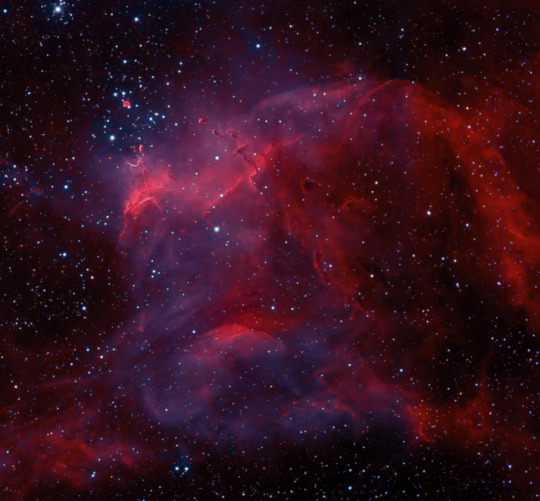Text


Eclipses l NASA
l 1️⃣ Lunar eclipse seen from Earth by NASA Glenn l 2️⃣ Solar eclipse seen from the Moon by Firefly Aearospace's Blue Ghost
727 notes
·
View notes
Text
Astronomy Picture of the Day
2025 March 15

Tololo Totality
Image Credit & Copyright: Petr Horálek/CTIO (Cerro Tololo Observatory) /AURA/NSF/ NOIRLab
On March 14 the Moon was Full. In an appropriate celebration of Pi day, that put the Moon 3.14 radians (180 degrees) in ecliptic longitude from the Sun in planet Earth's sky. As a bonus for fans of Pi and the night sky, on that date the Moon also passed directly through Earth's umbral shadow in a total lunar eclipse. In clear skies, the colors of an eclipsed Moon can be vivid. Reflecting the deeply reddened sunlight scattered into Earth's shadow, the darkened lunar disk was recorded in this time series composite image from Cerro Tololo Observatory, Chile. The lunar triptych captures the start, middle, and end of the total eclipse phase that lasted about an hour. A faint bluish tint seen just along the brighter lunar limb at the shadow's edge is due to sunlight filtered through Earth's stratospheric ozone layer.
Authors & editors: Robert Nemiroff (MTU) & Jerry Bonnell (UMCP)
NASA Official: Amber Straughn
A service of: ASD at NASA / GSFC,
NASA Science Activation
& Michigan Tech. U.
41 notes
·
View notes
Text
maybe this time picking at Textures on my skin will lead to being silky smooth
130K notes
·
View notes
Text
Last month NASA launched its long-awaited Europa Clipper, which will be one of the first missions to study Jupiter’s water world moon in detail. Since the early 70s, astronomers have found evidence that Europa contains a deep subsurface ocean under an icy outer layer, and many hoped that one day we might make it there to confirm it for ourselves. Europa Clipper represents the ultimate dream mission of astrobiologists, as the icy moon may contain ideal conditions for life floating in its massive ocean.
1 note
·
View note
Text
Last weekend marked two years since the launch of the first mission of the Artemis program, NASA’s sister to the famous Apollo missions. The uncrewed mission acted as a test flight for the Space Launch System (SLS) and Orion spacecraft, which will launch and carry future astronauts to the Moon.
So what did Artemis I tell us about our readiness to go back to the Moon, and what is the next step?
1 note
·
View note
Text
i just heard the phrase “if you wouldn’t trust their advice, don’t trust their criticism” for the first time and i don’t think i’ve ever needed to hear anything more
69K notes
·
View notes
Text
I didn’t miss that social cue I just thought it was stupid
195K notes
·
View notes
Text
The aurora last night were absolutely GORGEOUS!
If you want to learn more about yesterday's light show and what caused it, check out my latest blog post:
#my writing#aurora#northern lights#astronomy#science#space#astrophotography#women in stem#physics#astrophysics
0 notes
















